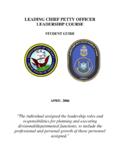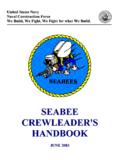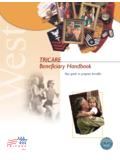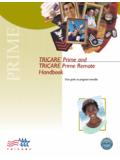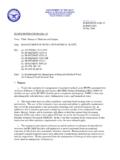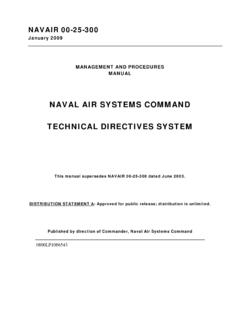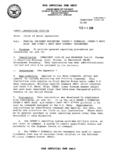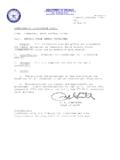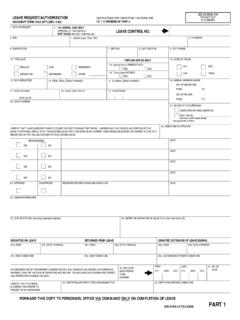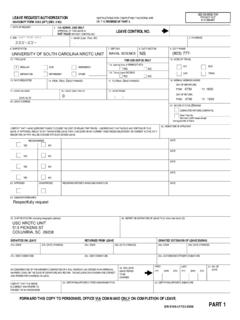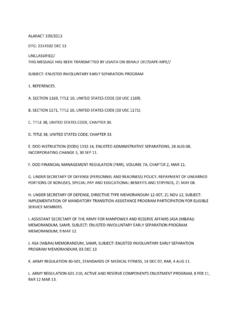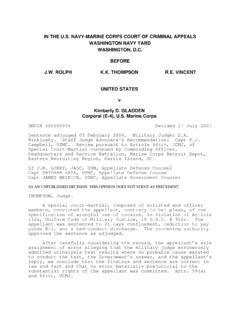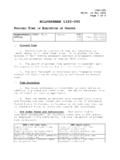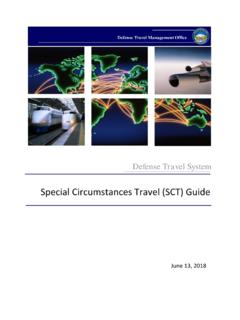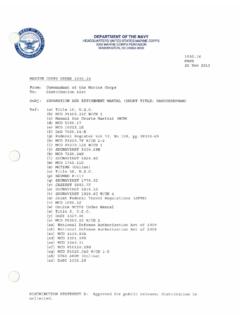Transcription of DEPARTMENT C)F' THE NAVY OF
1 DEPARTMENT C)F' T H E navy . OFFICE O F THE CHIEF O F NAVAL OPERATIONS. 2 0 0 0 navy PENTAGON. WASHINGTON. OPNAVINST N135. 9 Mar 07. OPNAV INSTRUCTION From: Chief of Naval Operations Subj: TRANSITION ASSISTANCE MANAGEMENT PROGRAM (TAMP). Ref: (a) 10 , 1141-1150. (b) DOD Instruction ( c ) DOD Directive (dl National Defense Authorization Act for FY-02. (el Veterans Education and Benefits Expansion Act of 2001. ( 1 SECNAVINST (9) SECNAVINST (h) MILPERSMAN 1910-804. (i) BUPERSINST (j) SECNAVINST (k) NAVPERS 15878J, Career Counselor Handbook 1. Purpose. To implement provisions of references (a) through (k) and issue policy and guidance for establishment and execution of the navy Transition Assistance Management Program (TAMP). This revision includes public law policy updates from 2002 through 2005 and should be reviewed in its entirety. Further guidance will be promulgated from the DEPARTMENT of Defense (DOD) to incorporate legislative provisions from the National Defense Authorization Acts of 2006 and 2007.))
2 2. Cancellation. OPNAVINST 3. Background a. TAMP was established in November 1990 to comply with Federal laws contained in reference (a) requiring all active and reserve component separating and retiring servicemembers, both officer and enlisted, to have access to permanent transition assistance services. Additionally, members who are being involuntarily separated (IVS) or involuntarily retired (IVR). also receive specific legislated transition benefits. A. qualifying separation program designator (SPD) is required to establish eligibility for transition benefits. OPNAVINST 9 Mar 07. b. The diverse complement of individual programs, services, and benefits, which collectively constitute TAMP, can be classified into four categories: (1) Pre-separation counseling. (2) Employment assistance. (3) Relocation assistance for separating members stationed overseas. (4) Benefits for members who are involuntarily separated or retired.
3 C. Delivery of TAMP services to all navy personnel will be achieved through a cooperative effort involving DOD, DEPARTMENT of Labor (DOL), and DEPARTMENT of Veterans Affairs (DVA), as well as many state, community, and non-profit service organizations. The intent of these services and benefits is to assist Sailors and their families in making informed and effective transition decisions as they prepare to return to civilian employment. This instruction is intended to facilitate this career change process and fully demonstrate the navy 's commitment to caring for its own. 4. Policv a. Mission. The primary mission of TAMP is to improve retention and mission readiness by providing professional career development resources to the military community throughout the career lifecycle. Transition assistance services prepare separating servicemembers and their families with the skills, tools, and self-confidence necessary to ensure successful reentry into the Nation's civilian work force.
4 TAMP is also intended to improve individual quality of life, enhance personal readiness, speed the attainment of career milestones, and return ambassadors to the civilian community that supports navy 's recruiting efforts. b. Applicability. Transition services and transition benefits are separate and distinct. (1) Transition Services. Every Sailor is eligible for and will have full access to transition services. Eligibility OPNAVINST 9 Mar 07. to receive these services is not affected by length or character of service. As authorized by reference (e), personnel are eligible to receive transition services as early as 24 months prior to retirement. Personnel voluntarily separating may access transition services 12 months prior to their separation date. Transition services are permanent programs for all separating members (voluntary or involuntary) which provide career change information through a variety of means such as: (a) Individual counseling.
5 (b) Workshops. (c) Job fairs. (d) Resources for research. (e) Employment preparation skills. (f) Automated systems. (2) Benefits. Specific entitlements (extension of medical coverage, excess leave/Permissive Temporary Additional Duty (PTDY) for job/house hunting, and hiring preference for non-appropriated fund instrumentalities (NAFI) positions) are granted to a limited, well-defined group of personnel who are involuntarily separated or retired. Per reference (d), previously authorized benefits (travel, transportation, household good storage, transitional commissary and exchange benefits, transitional use of military housing, continued enrollment in DEPARTMENT of Defense Dependents Schools (DODDS), and priority affiliation with National Guard and Reserve units). expired on 31 December 2001. (a) Transition Benefits - Separations. Certain IVS. servicemembers are eligible for transition benefits.
6 Eligibility for transition benefits depends - on the nature and characterization of a member's discharge. In general, members must meet the following conditions to be eligible for benefits: 1. Were on active duty or will be involuntarily - separated with a qualifying SPD code. OPNAVINST 9 Mar 07. 2. - Were or will be discharged under conditions characterized as either honorable or general under honorable conditions. (b) Transition Benefits - Retirement. Unlike transition benefits for IVS members, IVR members who retired prior to 26 March 1992 are not retroactively eligible for benefits. Members involuntarily retired (IVR) after 26 March 1992, as a result of a selected early retirement board (for all officer and enlisted personnel) or downward adjustment of high year tenure (HYT) limits (pay grades E6, E7, and E8) are eligible for transition benefits as described below: 1. Excess ~eave/~ermissive TDY.
7 IVR members may receive either excess leave for a period not to exceed 30. days or permissive TDY for a period not to exceed 20 days (30. days OCONUS) to facilitate member's relocation activities (such as job search and residence search). Leave/TEMADD is to be provided unless to do so would interfere with military missions. If members take excess leave it must be explained - to members that they will have to pay for excess leave at retirement and dollar amount at issue. To request this benefit, members must submit a NAVCOMPT 3065, Leave Request/~uthorization,with the words I1excess leave" written in the remarks section of NAVPERS. 1336/3, Special Request/Authorization, for permissive TDY. 2. One-time Hiring Preference. IVR members and their family members shall be provided a one-time preference - in hiring by a NAFI. A member or family member may apply for a NAFI position before or after retirement.
8 A person eligible for preference shall be referred for selection only if they are among the best qualified candidates after a competitive screening process is completed. Preferential hiring is terminated upon placement in, or declination of (whichever occurs first), a NAFI position for which application is made. To receive this benefit, IVR members and family members must show proof of involuntary retirement status at time of application . e l selected early retirement notification letter, separation orders, or letter from their commanding officer (CO)) . Employment options may be limited by overseas SOFAS or DEPARTMENT of State agreements. Consult local Human Resource Office (HRO) overseas for specific employment restrictions and guidelines. OPNAVINST 9 Mar 07. (3) Implementation. Each CO will ensure separating and retiring members, and their family members, receive transition services and benefits to which they are entitled.
9 To meet this requirement, each CO will designate a Command Transition Officer (CTO) (normally the command career counselor (CCC) for enlisted personnel and ship's secretary/administrative officer for officers), who will coordinate the command's transition program and will work closely with the TAMP staff identified in the paragraph below. The CTO will identify and personally counsel every prospective separating and retiring member, no later than 90 days prior to separation, advising them of locally available transition and resource assistance. To provide TAMP services, commands will implement one of two program models: (a) Installations designated as transition sites. All navy installations with a Fleet and Family Support Center (FFSC) are designated as "transition sites" for delivery of TAMP. services per reference (f). Transition sites that deliver TAMP. services may be located at: dav/lsnmedia/LS~/dodtransportal/.
10 Designation of these sites was based on size of geographical transitioning population (minimum of 500 active duty separations/retirements annually). At these sites, ~FsC/Fleetand Family Support Office (FFSO). staff with subject matter expertise in TAMP and support staff are responsible for coordinating all appropriate on and off-base resources into a comprehensive, widely advertised, and accessible transition program. This program will be the primary means through which members from local and tenant commands receive transition information and services. FFSC staff will work closely with all CTOs, within the FFSC area of responsibility, to ensure both individual and command requirements are fully identified and met. (b) Installations not designated as FFSO transition sites. For installations and commands which do not have access to a navy FFSC or have not been identified as an FFSO transition site, the CTO will coordinate transition services with the nearest DOD military installation offering transition services.
